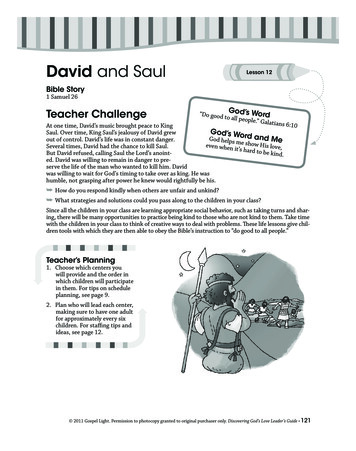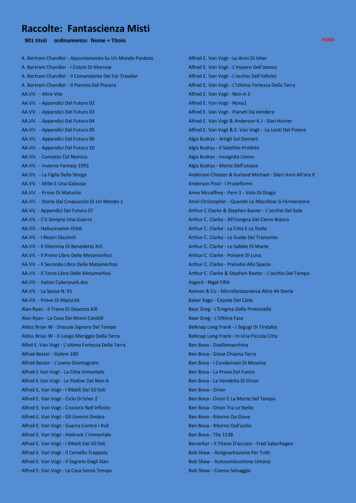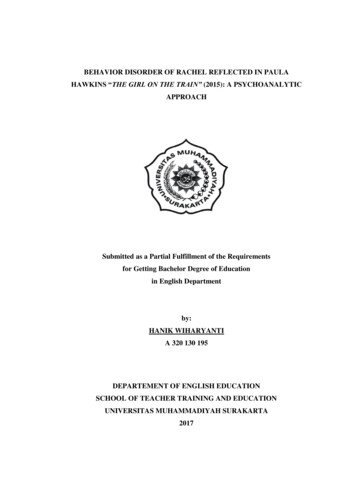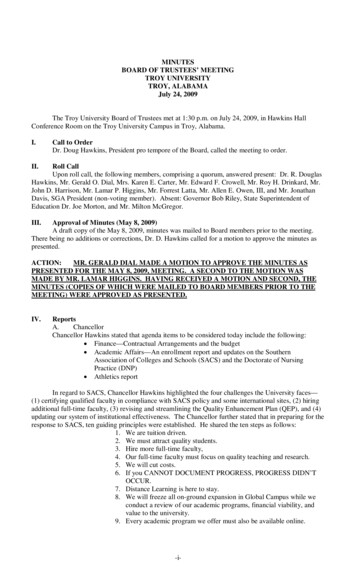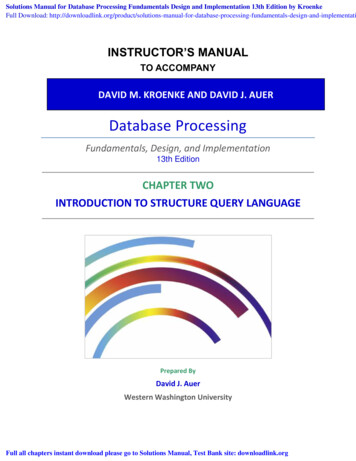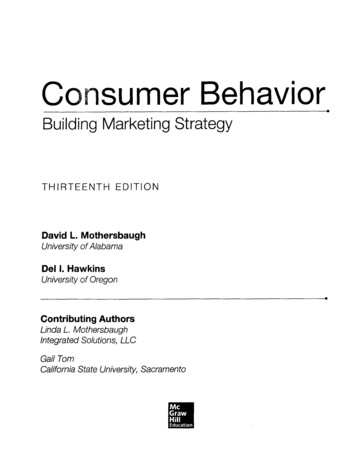
Transcription
ALSO BY DAVID R. HAWKINS, M.D., PH.D.Dissolving the Ego, Realizing the SelfAlong the Path to EnlightenmentHealing and RecoveryReality, Spirituality, and Modern ManDiscovery of the Presence of God: Devotional NondualityTranscending the Levels of Consciousness: The Stairway to EnlightenmentTruth vs. Falsehood: How to Tell the DifferenceI: Reality and SubjectivityThe Eye of the I: From Which Nothing Is HiddenPower vs. Force: The Hidden Determinants of Human BehaviorDialogues on Consciousness and SpiritualityQualitative and Quantitative Analysis and Calibration of the Levels of Human ConsciousnessOrthomolecular Psychiatry (with Linus Pauling)Please visit:Hay House USA: www.hayhouse.com Hay House Australia: www.hayhouse.com.auHay House UK: www.hayhouse.co.ukHay House South Africa: www.hayhouse.co.zaHay House India: www.hayhouse.co.in
Copyright 2012 by David R. HawkinsPublished and distributed in the United States by: Hay House, Inc.: www.hayhouse.com Publishedand distributed in Australia by: Hay House Australia Pty. Ltd.: www.hayhouse.com.au Published anddistributed in the United Kingdom by: Hay House UK, Ltd.: www.hayhouse.co.uk Published anddistributed in the Republic of South Africa by: Hay House SA (Pty), Ltd.: www.hayhouse.co.za Distributed in Canada by: Raincoast: www.raincoast.com Published in India by: Hay House PublishersIndia: www.hayhouse.co.inAll rights reserved. No part of this book may be reproduced by any mechanical, photographic, orelectronic process, or in the form of a phonographic recording; nor may it be stored in a retrieval system,transmitted, or otherwise be copied for public or private use—other than for “fair use” as brief quotationsembodied in articles and reviews—without prior written permission of the publisher.The author of this book does not dispense medical advice or prescribe the use of any technique as aform of treatment for physical, emotional, or medical problems without the advice of a physician, eitherdirectly or indirectly. The intent of the author is only to offer information of a general nature to help you inyour quest for emotional and spiritual well-being. In the event you use any of the information in this bookfor yourself, which is your constitutional right, the author and the publisher assume no responsibility foryour actions.Previously published by Veritas Publishing (ISBN 978-1-933885-98-8)Library of Congress Control Number for the printed edition: 2013947046Tradepaper ISBN: 978-1-4019-4501-516 15 14 13 4 3 2 11st Hay House edition, 2013Printed in the United States of America
Dedicated to removing the blocks to the Higher Self on the path toEnlightenment
CONTENTSTitle PageCopyright PageForewordPrefaceChapter 1: IntroductionChapter 2: The Mechanism of Letting GoWhat is it?Feelings and Mental MechanismsFeelings and StressLife Events and EmotionsMechanism of Letting GoResistance to Letting GoChapter 3: The Anatomy of EmotionsGoal of SurvivalScale of EmotionsUnderstanding EmotionsHandling Emotional CrisesHealing the PastEnhancing Positive EmotionsChapter 4: Apathy and Depression“I Can’t” vs. “I Won’t”BlameChoosing the PositiveThe Company We KeepChapter 5: GriefAllowing the GriefHandling LossPreventing Grief
Chapter 6: FearFear of Public SpeakingHealing Effect of LoveOwning the “Shadow”GuiltChapter 7: DesireDesire as an ObstacleHaving—Doing—BeingGlamourPower of Inner DecisionChapter 8: AngerUsing Anger Chronic ResentmentChapter 9: PrideVulnerability of PrideHumilityJoy and GratitudeOpinionsChapter 10: CourageCourage to Let GoSelf-EmpowermentAwareness of OthersChapter 11: AcceptanceEverything Is Perfect As It IsAcceptance of Self and OthersPersonal ResponsibilityChapter 12: LoveLove in Everyday LifeLove Heals
Unconditional LoveOnenessChapter 13: PeaceProfound Impact of PeaceSilent TransmissionSurrender to Ultimate RealityChapter 14: Reducing Stress and Physical IllnessPsychological Aspects and Stress PronenessMedical Aspects of StressEnergy System Response to Stress and the Acupuncture SystemInterventions to Alleviate StressKinesiologic TestingKinesiologic Testing TechniqueThe Relationship of Consciousness to Stress and DiseaseChapter 15: The Relationship between Mind and BodyInfluence of MindDisease-Prone BeliefsComparison with Other TechniquesChapter 16: The Benefits of Letting GoEmotional GrowthProblem SolvingLifestyleResolution of Psychological Problems: Comparison withPsychotherapyChapter 17: TransformationHealthWealthHappinessState of Inner FreedomChapter 18: RelationshipsNegative FeelingsThe Human Condition
Positive FeelingsSexual RelationsChapter 19: Achievement of Vocational GoalsFeelings and AbilitiesNegative Feelings Related to WorkPositive Feelings Related to WorkFeelings and the Decision-Making ProcessFeelings and Sales AbilityChapter 20: Physician, Heal ThyselfBasic PrinciplesHealing of Multiple DiseasesHealing of VisionChapter 21: Questions and AnswersReligious and Spiritual GoalsMeditation and Inner TechniquesPsychotherapyAlcoholism and Drug AddictionRelationshipsThe MechanismSurrender to the UltimateAppendix A: Map of ConsciousnessAppendix B: Muscle Testing ProcedureReferencesAbout the Author
FOREWORDThis book provides a mechanism by which to unlock our innate capacities forhappiness, success, health, well-being, intuition, unconditional love, beauty,inner peace, and creativity. These states and capacities are within all of us. Theydo not depend on any outer circumstance or personal characteristic; they do notrequire belief in any religious system. No single group or system owns innerpeace, as it belongs to the human spirit by virtue of our origin. This is theuniversal message of every great teacher, sage, and saint: “The kingdom ofheaven is within you.” Dr. Hawkins says frequently, “What you are seeking isnot different from your very own Self.”How can something innate to us—part and parcel of our true being—be sodifficult to attain? Why all the unhappiness if we were endowed with happiness?If the “kingdom of heaven” is within us, why do we often “feel like hell”? Howcan we get free of the sludge of non-peace that makes our journey to inner peaceseem so arduous, like molasses running uphill on a freezing cold day? It’s niceto hear that peace, happiness, joy, love, and success are intrinsic to our humanspirit. But what about all of the anger, sadness, despair, vanity, jealousy,anxieties, and daily little judgments that muffle the pristine sound of silencewithin us? Is there really a way to shake off the sludge and be free? Dance withunimpeded joy? Love all living things? Live in our greatness and fulfill ourhighest potential? Become a channel of grace and beauty in the world?In this book, Dr. Hawkins offers a pathway to the freedom that we long forbut find difficult to attain. It may sound counter-intuitive to get somewhere by“letting go”; however, he certifies from clinical and personal experience thatsurrender is the surest route to total fulfillment.Many of us have been raised to correlate worldly and even spiritualaccomplishment with “hard work,” “keeping our nose to the grindstone,” “livingby the sweat of our brow,” and other self-stringent axioms inherited from aculture steeped in the Protestant ethic. According to this view, success requiressuffering, toil, and effort: “no pain, no gain.” But where has all the effort andpain gotten us? Are we truly, deeply at peace? No. There is still the inner guilt,the vulnerability to someone’s criticism, the wanting to be assured, and theresentments that fester.If you’re reading this book, you’ve probably already reached the end of your
rope with the mechanism of effort. Perhaps you’ve seen that the more you pullon the rope to hitch yourself up to where you want to be, the more frazzled andfrayed it becomes. Possibly, you might be wondering, “Isn’t there an easier,better way?” Are you willing to let go of the rope? What would it be like toutilize the mechanism of surrender instead of the mechanism of effort?I can share what it was like for a highly educated person who had alreadytried many different methods of self-improvement. Despite professional success,there were physical and emotional problems that never seemed to improve and,eventually, reached a breaking point. The encounter with Dr. David R. Hawkinsand his writings catalyzed a healing effect that was unexpected and dramatic.At first, there was skepticism. Having explored various spiritual,philosophical, and religious avenues with unfulfilling or only temporary results,I approached my study of Hawkins with the thought, “It will probably turn outlike the rest.” However, the conscientious seeker in me said, “I’ll check it out.What have I got to lose?” So, I read Power vs. Force: The HiddenDeterminants of Human Behavior. When the book was finished, there was theinner realization, “I’m a changed person from the one who picked up this book.”That was in 2003. Now, many years later, the catalytic effect is still operating inall areas of life.What convinced me of the truth of his work, ultimately, were thetransformations in my own physical and nonphysical consciousness. There wereempirical facts that I could not deny: the healing of an addiction that had beenpreviously impossible to overcome, despite many sincere attempts; freedomfrom several allergies (pet dander, poison ivy, mold, hay fever); letting go oflong-standing resentments, with a capacity to see the hidden gifts within thevarious life traumas I had been through; alleviation of several life-long fears andan anxiety disorder that had severely limited my career and personal life;resolution of several inner conflicts related to self-acceptance and life purpose.These major breakthroughs at the physical and nonphysical levels wereconcretely observable not only by myself but by those around me. They wouldask, “How do you explain the transformation?” Now, if faced with that question,I will suggest that they read this new book, Letting Go: The Pathway ofSurrender. It lays out the pragmatics of the inner process of transformation thatwas experienced upon reading his earlier books.Letting Go: The Pathway of Surrender provides the roadmap to a freer lifefor anyone who is willing to make the trip. Your life will be changed for thebetter if you apply the principles described in this book. They are not difficult tounderstand or to implement. They do not cost anything. They do not requirespecial attire or travel to an exotic country. The major requirement for the
journey is a willingness to let go of the attachment to your current experience oflife.As Dr. Hawkins explains, the “small” part of ourselves is attached to thefamiliar, no matter how painful or inefficient it is. It may seem bizarre, but ourself with a small “s” actually enjoys an impoverished life and all the negativitythat goes with it: feeling unworthy, being invalidated, judging others andourselves, being inflated, always “winning” and being “right,” grieving the past,fearing the future, nursing our wounds, craving assurance, and seeking loveinstead of giving it.Are we willing to imagine a new life for ourselves, characterized byeffortless success, freedom from resentment, gratitude for all that’s happened tous, inspiration, love, joy, win-win resolutions, happiness, and creativeexpression? One of the biggest hurdles to happiness, he tells us, is the belief thatit isn’t possible: “There’s got to be a catch”; “It’s too good to be true”; “It canhappen for others but not for me.”The gift of a person and teacher like Dr. Hawkins is that we see andexperience a being who IS that happiness; who IS that boundless joy; who ISthat unassailable peace. The book was written because he himself experiencedthe power of the mechanism it describes. To read about and be in the presence ofsuch a liberated being gives us the catalyst, the hope, and the launch for our owninward trek. And so, despite the cynicism of the small self, there is the Self thatbeckons us on. We may first hear its call as coming from an advancedconsciousness such as Dr. Hawkins, a teacher, a guide, or a sage who hasrealized the Self. Then, as we have our own experiences of truth, healing, andexpansion, we hear the call as coming from an inner place. “The Self of theteacher and that of the student are one and the same,” says Dr. Hawkins.He radiates the truths of this book. As a serious seeker who saw much ofcontemporary spiritual writing as shallow, I wanted to verify the authenticity ofthis work. It was all-important to know: does this author speak from a true innerRealization? The answer is “Yes!” Close observations made during several yearsof interviews and visits confirmed the advanced state. In this book, he remindsus of the law of consciousness that says: We are all connected at the energeticlevel, and a higher vibration (such as love) has a powerful effect on a lowervibration (such as fear). I feel the truth of this law whenever I am with him; hisenergy field transmits healing love and profound peace. As he explains in thisbook, these higher states are available to all of us at any time.No matter where we are in life, this book will illumine a “next step.” Themechanism of surrender that Dr. Hawkins describes is applicable to the entireinner journey: from the letting go of childhood resentments to the final surrender
of the ego itself. Thus, the book is equally useful for the professional interestedin worldly success, the client in therapy seeking to heal emotional issues, thepatient diagnosed with an illness, and the spiritual seeker devoted toEnlightenment. The important step for all of us, he advises, is to acknowledgethat we have negative feelings as a consequence of our human condition, and tobe willing to look at them without judgment. The high state of non-dualawareness may be our goal. But how do we handle the persistently dualistic“small self” that wants us to see ourselves as “better than” or “worse than”another?In his previous ten books, Dr. Hawkins has described the non-dual state ofEnlightenment with rare pristine awareness. As he says humorously at the startof many lectures, “We begin with the end.” Indeed, in his lectures and books, hehas thoroughly illuminated the highest states of consciousness that are theculmination of human inner evolution.Now, in this book published in the latter part of his life, he is taking us backto our common starting point: acknowledging the existence of the small self. Wemust start where we are to get to where we want to go! If we want to go fromhere to there, we don’t get there faster if we fool ourselves and say we arestarting from nearby. By thinking we’re closer than we are to the goal, weactually make the trip longer. As he explains in the book, it takes courage andself-honesty to see negativity and smallness in ourselves. Only when we canacknowledge the negativity that we’ve inherited from the human condition willwe have the possibility to surrender and be free of it. We simply need to bewilling to acknowledge and accept that part of our human experience. Byaccepting it, we can transcend it—and Dr. Hawkins shows us the way.In this highly pragmatic book, he illumines a technique by which we cantranscend the small self and break through to the freedom for which we long.This state of inner freedom and unalloyed happiness is our “birthright,” he says.As we read, we draw encouragement and inspiration from the real-life clinicalexamples that he shares from his decades of psychiatric practice. In case aftercase, we see the power of surrender applied to nearly every area of life:relationships, physical health, work environments, recreational activities,spiritual process, family life, sexuality, emotional healing, and addictionrecovery.We learn that the answer to the problems we face is within us. By letting goof the inner blocks to it, the truth of our inner Self shines forth and the path topeace is revealed. Other spiritual teachers have emphasized the cultivation ofinner peace as the only real solution to personal difficulties, as well as collectiveconflicts: “Inner disarmament first, then outer disarmament” (The Dalai Lama);
“Be the change you want to see in the world” (Gandhi). The implication is clear.Because we are all part of the whole, when we heal something in ourselves, weheal it for the world. Each individual consciousness is connected to thecollective consciousness at the energetic level; therefore, personal healingemerges collective healing. Dr. Hawkins may be the first to attempt tounderstand this principle in light of scientific and clinical applications. Thecrucial point is: by changing ourselves, we change the world. As we becomemore loving on the inside, healing occurs on the outside. Much like the rising ofthe sea level lifts all ships, so the radiance of unconditional love within a humanheart lifts all of life.Dr. David R. Hawkins is a world-renowned author, psychiatrist, clinician,spiritual teacher, and researcher of consciousness. Details of his extraordinarylife are given in the “About the Author” section at the back of the book. Hisunique work effulges from a wellspring of universal compassion and isdedicated to the alleviation of suffering in all dimensions of life. The gift of Dr.Hawkins’ work to human evolvement is beyond what can be said about it.The state of Enlightenment is totally complete in its bliss, such that onewould never leave it except out of a total surrender of love to God and to one’sfellow human beings, to share the gift that was given. This book on letting go,and all of his work in the world, is the result of that surrender. As you will readin one of the chapters, there was a very deep surrender that allowed theresumption of his personal consciousness in order to fulfill certain commitmentsin the world. The state of oneness was not lost or left, but extraordinary love hadto be directed toward the challenge of verbalizing the ineffable. You will noticethat some of his pronouns do not fit grammatical convention—for example, “ourlife”—yet they are true to the experience of a spiritual state that knows theimpersonal oneness of all life. That Dr. Hawkins would re-enter the world oflogic and language in order to share a “Map of Consciousness” with us—so thatwe might also complete our destiny—speaks volumes of his selfless love forhumanity. By showing us the way to liberation, Dr. Hawkins gives us the chanceof reaching it.Thank you, Dr. Hawkins, for the gift of total surrender.Fran Grace, Ph.D., editor.Professor of Religious Studies andSteward of the Meditation RoomUniversity of Redlands, CaliforniaFounding Director, Institute for
Contemplative LifeSedona, ArizonaJune 2012
PREFACEDuring many years of clinical psychiatric practice, the primary aim was to seekthe most effective ways to relieve human suffering in all of its many forms. Tothis end, numerous disciplines of medicine, psychology, psychiatry,psychoanalysis, behavioral techniques, bio-feedback, acupuncture, nutrition, andbrain chemistry were explored. Beyond these clinical modalities werephilosophical systems, metaphysics, a multitude of holistic health techniques,self-improvement courses, spiritual pathways, meditative techniques, and otherways to expand one’s awareness.In all of these explorations, the mechanism of surrender was found to be ofgreat practical benefit. Its importance necessitated the writing of this book toshare with others what was clinically observed and personally experienced.The previous ten books focused on advanced states of awareness andEnlightenment. Over the years, thousands of students at our lectures andSatsangs have asked questions that reveal the everyday obstacles toEnlightenment. It is pragmatic and helpful to share a technique that will facilitatetheir success in overcoming such obstacles: How to handle the vicissitudes ofordinary life, with its losses, disappointments, stresses, and crises? How to befree of negative emotions and their impact on health, relationships, and work?How to handle all of the unwanted feelings? The present work describes asimple and effective means by which to let go of negative feelings and becomefree.The letting go technique is a pragmatic system of eliminating obstacles andattachments. It can also be called a mechanism of surrender. There is scientificproof of its efficacy, an explanation of which is included in one of the chapters.Research has shown the technique to be more effective than many otherapproaches currently available in relieving the physiologic responses to stress.After researching most of the various stress-reduction and consciousnessmethods, this approach stands out for its sheer simplicity, efficiency, clinicalefficacy, absence of questionable concepts, and rapidity of observable results. Itssimplicity is deceptive and almost disguises the real benefit of the technique.Simply stated, it sets us free from emotional attachments. It verifies theobservation made by every sage, that attachments are the primary cause ofsuffering.
The mind, with its thoughts, is driven by feelings. Each feeling is thecumulative derivative of many thousands of thoughts. Because most peoplethroughout their lives repress, suppress, and try to escape from their feelings, thesuppressed energy accumulates and seeks expression through psychosomaticdistress, bodily disorders, emotional illnesses, and disordered behavior ininterpersonal relationships. The accumulated feelings block spiritual growth andawareness, as well as success in many areas of life.The benefits of this technique can, therefore, be described on various levels:Physical:The elimination of suppressed emotions has a positive health benefit. Itdecreases the overflow of energy into the body’s autonomic nervous system, andit unblocks the acupuncture energy system (demonstrable by a simple muscletest). Therefore, as a person constantly surrenders, physical and psychosomaticdisorders improve and frequently disappear altogether. There is a generalreversal of pathologic processes in the body and a return to optimal functioning.Behavioral:Because there is a progressive decrease of anxiety and negative emotions, thereis less and less need for escapism via drugs, alcohol, entertainment, andexcessive sleep. Consequently, there is an increase in vitality, energy, presence,and well-being, with more efficient and effortless functioning in all areas.Interpersonal Relationships:As negative feelings are surrendered, there is a progressive increase of positivefeelings that results in quickly observable improvement in all relationships.There is an increase in the capacity to love. Conflicts with others decreaseprogressively, so that job performance improves. The elimination of negativeblocks allows vocational goals to be more easily accomplished, and selfsabotaging behavior based on guilt progressively diminishes. There is less andless dependence on intellectualism and a greater use of intuitive knowingness.With the resumption of personality growth and development, there is often theuncovering of previously unsuspected creative and psychic abilities, which arethwarted in all people by suppressed negative emotions. Of great importance isthe progressive diminution of dependency, the bane of all human relationships.Dependency underlies so much pain and suffering; it includes even violence andsuicide as its ultimate expression. As dependency diminishes, there is also adiminution of aggressiveness and hostile behavior. These negative feelings are
replaced by feelings of acceptance and lovingness toward others.Consciousness/ Awareness/ Spirituality:This is an area that opens up by continuous use of the mechanism of surrender.The letting go of negative emotions means that the person experiences everincreasing happiness, contentment, peace, and joy. There is an expansion ofawareness, progressive realization, and experiencing of the real inner Self. Theteachings of the Great Masters unfold from within as one’s own personalexperience. The progressive letting go of limitations allows the realization at lastof one’s true identity. Letting go is one of the most efficacious tools by which toreach spiritual goals.Anyone can accomplish all of these ends, with gentleness and subtlety, asone silently surrenders throughout daily life. The progressive disappearance ofnegativity and its replacement by positive feelings and experiences is pleasurableboth to watch and to experience. It is the purpose of this information to assist thereader in having those rewarding experiences.David R. Hawkins, M.D., Ph.D.Founding President,Institute for Spiritual ResearchSedona, ArizonaJune 2012
CHAPTER1INTRODUCTIONWhile in contemplation one day, the mind said:“What in the world is wrong with us?”“Why doesn’t happiness stay put?”“Where are the answers?”“How do we address the human dilemma?”“Have I gone nuts or has the world gone crazy?”The solution to any problem seems to bring only brief relief, for it is thevery basis of the next problem.“Is the human mind a hopeless squirrel cage?”“Is everybody confused?”“Does God know what He’s doing?”“Is God dead?”The mind just kept chattering along:“Does anybody have the secret?”Don’t worry—everybody’s desperate. Some seem cool about it. “I can’t seewhat all the fuss is about,” they say. “Life seems simple to me.” They are soscared they can’t even look at it!How about the experts? Their confusion is more sophisticated, wrapped in
impressive jargon and elaborate mental construction. They have predeterminedbelief systems into which they try to squeeze you. It seems to work for a whileand, then, it is just back to one’s original state again.It used to be that we could count on social institutions, but they have hadtheir day; nobody trusts them any more. We now have more watchdogs thaninstitutions. The hospitals are monitored by multiple agencies. Nobody has timefor the patients, who get lost in the shuffle. Look down the corridors. There areno doctors or nurses. They are in the offices doing paperwork. The whole sceneis dehumanized.“Well,” you say, “there have to be some experts who have the answers.”When upset, you go to a doctor or psychiatrist, an analyst, a social worker, or anastrologer. You take up religion, get philosophy, take the Erhard SeminarsTraining (est), tap yourself with EFT. You get your chakras balanced, try somereflexology, go for ear acupuncture, do iridology, get healed with lights andcrystals.You meditate, chant a mantra, drink green tea, try the Pentecostals, breathein fire, and speak in tongues. You get centered, learn NLP, try actualizations,work on visualizations, study psychology, join a Jungian group. You get Rolfed,try psychedelics, get a psychic reading, jog, jazzercise, have colonics, get intonutrition and aerobics, hang upside down, wear psychic jewelry. Get moreinsight, bio-feedback, Gestalt therapy.You see your homeopath, chiropractor, naturopath. You try kinesiology,discover your Enneagram type, get your meridians balanced, join aconsciousness-raising group, take tranquilizers. You get some hormone shots, trycell salts, have your minerals balanced, pray, implore, and beseech. You learnastral projection. Become a vegetarian. Eat only cabbage. Try macrobiotics, goorganic, eat no GMO. Meet up with Native American medicine men, do a sweatlodge. Try Chinese herbs, moxicombustion, shiatsu, acupressure, feng shui. Yougo to India. Find a new guru. Take off your clothes. Swim in the Ganges. Stareat the sun. Shave your head. Eat with your fingers, get really messy, shower incold water.Sing tribal chants. Relive past lives. Try hypnotic regression. Scream aprimal scream. Punch pillows. Get Feldenkraised. Join a marriage encountergroup. Go to Unity. Write affirmations. Make a vision board. Get re-birthed.Cast the I Ching. Do the Tarot cards. Study Zen. Take more courses andworkshops. Read lots of books. Do transactional analysis. Get yoga lessons. Getinto the occult. Study magic. Work with a kahuna. Take a shamanic journey. Situnder a pyramid. Read Nostradamus. Prepare for the worst.Go on a retreat. Try fasting. Take amino acids. Get a negative ion generator.
Join a mystery school. Learn a secret handshake. Try toning. Try color therapy.Try subliminal tapes. Take brain enzymes, antidepressants, flower remedies. Goto health spas. Cook with exotic ingredients. Look into strange fermentedoddities from faraway places. Go to Tibet. Hunt up holy men. Hold hands in acircle and get high. Renounce sex and going to the movies. Wear some yellowrobes. Join a cult.Try the endless varieties of psychotherapy. Take wonder drugs. Subscribe tolots of journals. Try the Pritikin diet. Eat just grapefruit. Get your palm read.Think New Age thought. Improve the ecology. Save the planet. Get an aurareading. Carry a crystal. Get a Hindu sidereal astrological interpretation. Visit atransmedium. Go for sex therapy. Try Tantric sex. Get blessed by BabaSomebody. Join an anonymous group. Travel to Lourdes. Soak in the hotsprings. Join Arica. Wear therapeutic sandals. Get grounded. Get more prana andbreathe out that stale black negativity. Try golden needle acupuncture. Check outsnake gallbladders. Try chakra breathing. Get your aura cleaned. Meditate inCheops, the great pyramid in Egypt.You and your friends have tried all of the above, you say? Oh, the human!You wonderful creature! Tragic, comic and yet so noble! Such courage to keepon searching! What drives us to keep looking for an answer? Suffering? Oh, yes.Hope? Certainly. But there is something more than that.Intuitively, we know that somewhere there is an ultimate answer. Westumble down dark byways into cul-de-sacs and blind alleys; we get exploitedand taken, disillusioned, fed up, and we keep on trying.Where is our blind spot? Why can’t we find the answer?We don’t understand the problem; that’s why we can’t find the answer.Maybe it’s ultra simple, and that’s why we can’t see
In this book, Dr. Hawkins offers a pathway to the freedom that we long for but find difficult to attain. It may sound counter-intuitive to get somewhere by "letting go"; however, he certifies from clinical and personal experience that surrender is the surest route to total fulfillment.
![No, David! (David Books [Shannon]) E Book](/img/65/no-20david-20david-20books-20shannon-20e-20book.jpg)
